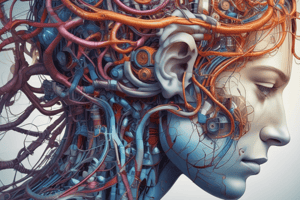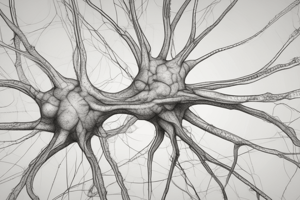Podcast
Questions and Answers
What is the primary function of upper motor neurons?
What is the primary function of upper motor neurons?
- To regulate muscle stretch reflexes
- To transmit sensory information from the spinal cord
- To send axons directly to skeletal muscle cells
- To control lower motor neurons and their activity (correct)
Where are the somas of upper motor neurons primarily found?
Where are the somas of upper motor neurons primarily found?
- In the cerebral cortex (correct)
- In the spinal cord
- In the brain stem
- In the skeletal muscle cells
What is the corticospinal tract?
What is the corticospinal tract?
- A collection of axons that travel from the brain stem to skeletal muscle cells
- A collection of axons that travel from the cerebral cortex to lower motor neurons in the spinal cord (correct)
- A collection of axons that travel from the spinal cord to the brain stem
- A collection of axons that travel from the spinal cord to the cerebral cortex
What is a sign of upper motor neuron dysfunction?
What is a sign of upper motor neuron dysfunction?
What is the result of dysfunction of the corticospinal tract on one side of the spinal cord?
What is the result of dysfunction of the corticospinal tract on one side of the spinal cord?
Which of the following statements about upper motor neurons is true?
Which of the following statements about upper motor neurons is true?
What is the primary difference between the corticospinal tract and the corticobulbar tract?
What is the primary difference between the corticospinal tract and the corticobulbar tract?
What is the result of dysfunction of the corticobulbar tract?
What is the result of dysfunction of the corticobulbar tract?
What can occur with or without weakness as a result of upper motor neuron dysfunction?
What can occur with or without weakness as a result of upper motor neuron dysfunction?
Dysfunction of which neurons can cause weakness?
Dysfunction of which neurons can cause weakness?
In which part of the central nervous system do the axons of upper motor neurons primarily synapse?
In which part of the central nervous system do the axons of upper motor neurons primarily synapse?
A person exhibits weakness on the left side of their body. If the dysfunction is in the corticospinal tract, where is the likely location of the lesion?
A person exhibits weakness on the left side of their body. If the dysfunction is in the corticospinal tract, where is the likely location of the lesion?
What is the term for rhythmic contraction of antagonist muscles, often seen in upper motor neuron dysfunction?
What is the term for rhythmic contraction of antagonist muscles, often seen in upper motor neuron dysfunction?
A patient exhibits hypertonia and clonus in their legs. What is the likely site of the lesion?
A patient exhibits hypertonia and clonus in their legs. What is the likely site of the lesion?
What is the direction of information flow in the corticospinal tract?
What is the direction of information flow in the corticospinal tract?
Flashcards are hidden until you start studying
Study Notes
Upper Motor Neurons
- Different from lower motor neurons, which have somas in the brain stem or spinal cord and send axons to skeletal muscle cells
- Upper motor neurons control lower motor neurons and their activity
- Somas of upper motor neurons are found mainly in the cerebral cortex
- Axons of upper motor neurons descend to synapse on lower motor neurons in the brain stem or spinal cord
- Information flows from the cerebral cortex down the axons to lower motor neuron somas and then to skeletal muscle cells
Corticospinal Tract
- A collection of axons that travel from the cerebral cortex to lower motor neurons in the spinal cord
- Most axons cross over to the other side of the spinal cord before synapsing on lower motor neurons
- Dysfunction of the corticospinal tract on one side of the spinal cord usually results in weakness on the same side of the body
- Dysfunction of the corticospinal tract on the other side of the brain results in weakness on the opposite side of the body
Corticobulbar Tract
- A collection of axons that travel from the cerebral cortex to lower motor neurons in the brain stem
- Upper motor neuron axons often innervate lower motor neurons on the same side of the brain stem
- Dysfunction of the corticobulbar tract can result in different patterns of weakness
Upper Motor Neuron Signs
- Hyperreflexia: an increase in muscle stretch reflexes
- Clonus: rhythmic contraction of antagonist muscles
- Hypertonia: increased tone of skeletal muscles
- Extensor Plantar Response (Babinski Sign): abnormal extension of the toes in response to scraping the bottom of the foot
Dysfunction
- Dysfunction of either lower motor neurons or upper motor neurons can cause weakness
- Upper motor neuron signs can occur with or without weakness, and can help distinguish between upper and lower motor neuron dysfunction
Upper Motor Neurons
- Upper motor neurons control lower motor neurons and their activity
- Found mainly in the cerebral cortex
- Axons descend to synapse on lower motor neurons in the brain stem or spinal cord
- Information flows from the cerebral cortex down the axons to lower motor neuron somas and then to skeletal muscle cells
Corticospinal Tract
- Collection of axons from the cerebral cortex to lower motor neurons in the spinal cord
- Most axons cross over to the other side of the spinal cord before synapsing on lower motor neurons
- Dysfunction on one side of the spinal cord results in weakness on the same side of the body
- Dysfunction on the other side of the brain results in weakness on the opposite side of the body
Corticobulbar Tract
- Collection of axons from the cerebral cortex to lower motor neurons in the brain stem
- Upper motor neuron axons often innervate lower motor neurons on the same side of the brain stem
- Dysfunction results in different patterns of weakness
Upper Motor Neuron Signs
- Hyperreflexia: increased muscle stretch reflexes
- Clonus: rhythmic contraction of antagonist muscles
- Hypertonia: increased tone of skeletal muscles
- Extensor Plantar Response (Babinski Sign): abnormal extension of the toes in response to scraping the bottom of the foot
Dysfunction
- Dysfunction of either lower motor neurons or upper motor neurons can cause weakness
- Upper motor neuron signs can occur with or without weakness, and help distinguish between upper and lower motor neuron dysfunction
Upper Motor Neurons
- Upper motor neurons control lower motor neurons and their activity
- Found mainly in the cerebral cortex
- Axons descend to synapse on lower motor neurons in the brain stem or spinal cord
- Information flows from the cerebral cortex down the axons to lower motor neuron somas and then to skeletal muscle cells
Corticospinal Tract
- Collection of axons from the cerebral cortex to lower motor neurons in the spinal cord
- Most axons cross over to the other side of the spinal cord before synapsing on lower motor neurons
- Dysfunction on one side of the spinal cord results in weakness on the same side of the body
- Dysfunction on the other side of the brain results in weakness on the opposite side of the body
Corticobulbar Tract
- Collection of axons from the cerebral cortex to lower motor neurons in the brain stem
- Upper motor neuron axons often innervate lower motor neurons on the same side of the brain stem
- Dysfunction results in different patterns of weakness
Upper Motor Neuron Signs
- Hyperreflexia: increased muscle stretch reflexes
- Clonus: rhythmic contraction of antagonist muscles
- Hypertonia: increased tone of skeletal muscles
- Extensor Plantar Response (Babinski Sign): abnormal extension of the toes in response to scraping the bottom of the foot
Dysfunction
- Dysfunction of either lower motor neurons or upper motor neurons can cause weakness
- Upper motor neuron signs can occur with or without weakness, and help distinguish between upper and lower motor neuron dysfunction
Upper Motor Neurons
- Upper motor neurons control lower motor neurons and their activity
- Found mainly in the cerebral cortex
- Axons descend to synapse on lower motor neurons in the brain stem or spinal cord
- Information flows from the cerebral cortex down the axons to lower motor neuron somas and then to skeletal muscle cells
Corticospinal Tract
- Collection of axons from the cerebral cortex to lower motor neurons in the spinal cord
- Most axons cross over to the other side of the spinal cord before synapsing on lower motor neurons
- Dysfunction on one side of the spinal cord results in weakness on the same side of the body
- Dysfunction on the other side of the brain results in weakness on the opposite side of the body
Corticobulbar Tract
- Collection of axons from the cerebral cortex to lower motor neurons in the brain stem
- Upper motor neuron axons often innervate lower motor neurons on the same side of the brain stem
- Dysfunction results in different patterns of weakness
Upper Motor Neuron Signs
- Hyperreflexia: increased muscle stretch reflexes
- Clonus: rhythmic contraction of antagonist muscles
- Hypertonia: increased tone of skeletal muscles
- Extensor Plantar Response (Babinski Sign): abnormal extension of the toes in response to scraping the bottom of the foot
Dysfunction
- Dysfunction of either lower motor neurons or upper motor neurons can cause weakness
- Upper motor neuron signs can occur with or without weakness, and help distinguish between upper and lower motor neuron dysfunction
Studying That Suits You
Use AI to generate personalized quizzes and flashcards to suit your learning preferences.




